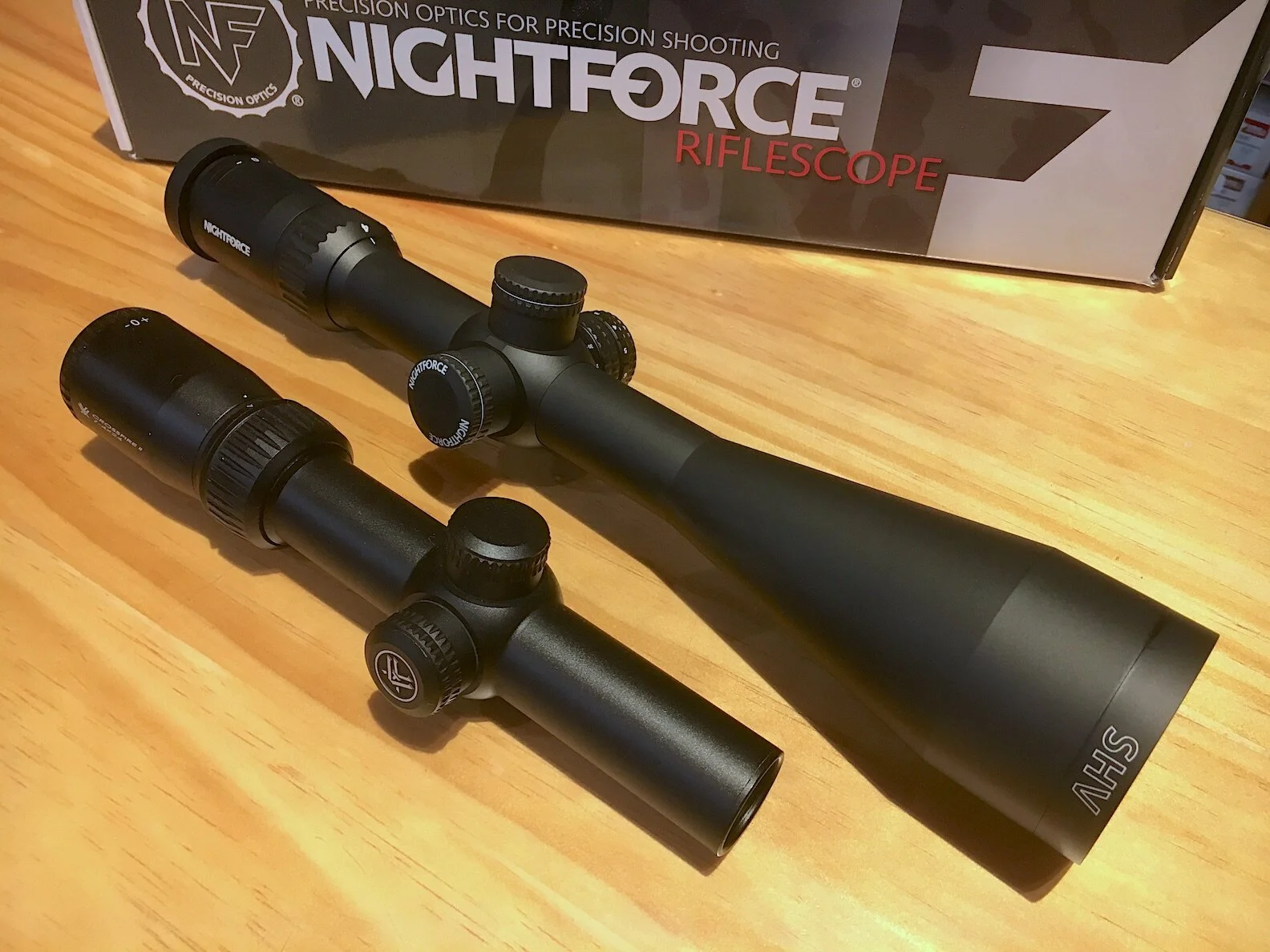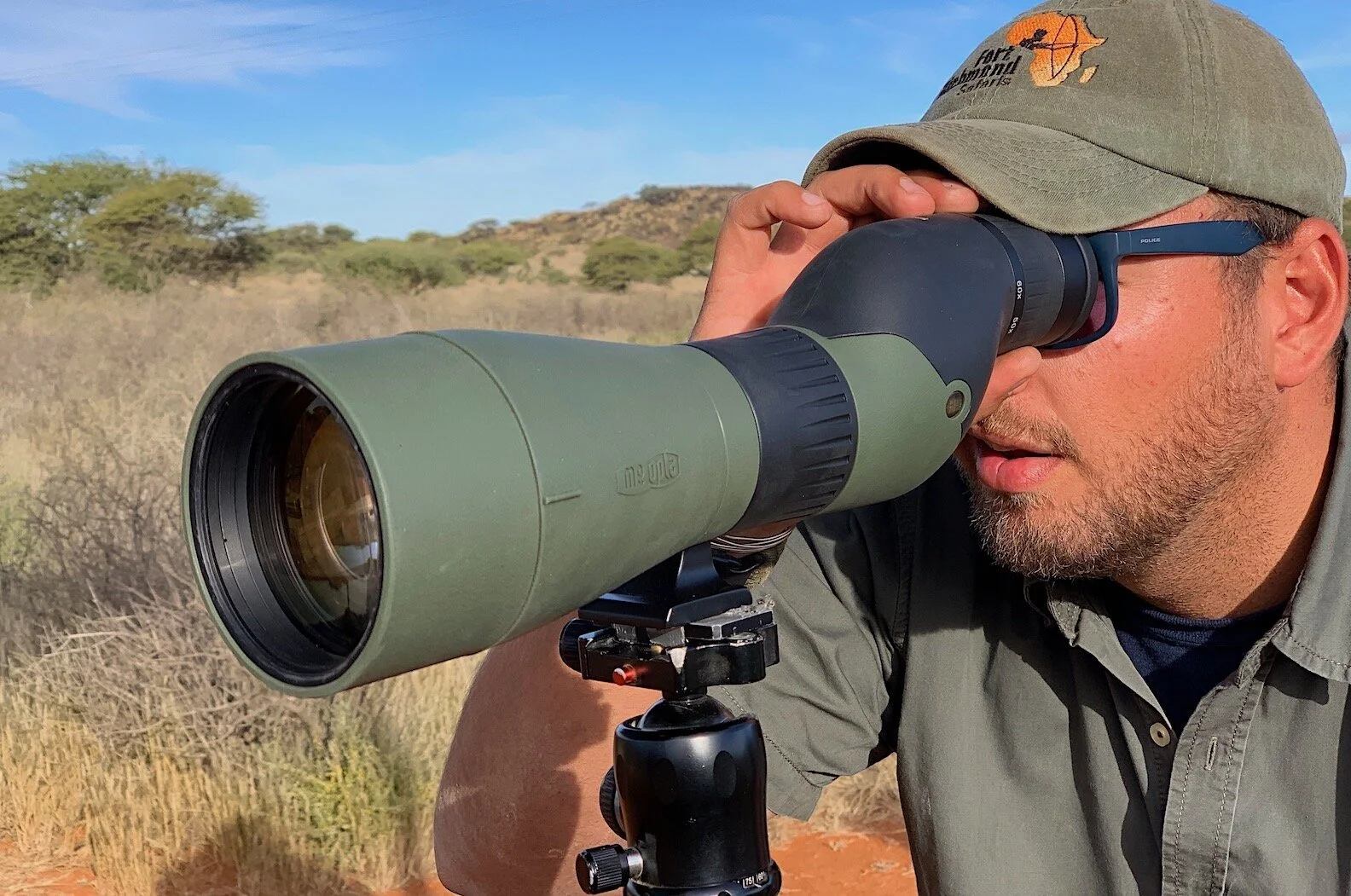Pining for the Right Pocket Binocular
An 8X20mm pocket binocular beside a mid-sized 8x42mm "standard binocular.
Exit Pupil diameter on 10x25mm top binocular is 2.5mm. Bottom 10x50mm instrument yields 5mm EP. Much brighter, but much heavier.
The 42mm objective lenses at right allow much more light to enter the binocular than do the 20mm objectives on the left.
I love the performance of Leupold's 6x30mm Yosemite Porro prism, the smallest 6X binoculars I know.
Here's looking at you, kid.
Pocket Binocular Perfection I guess we, the buying public, are to blame. We've got that all-American "bigger is better" syndrome. But optics manufacturers should know better. Ten-power pocket binoculars just aren't all that effective.Neither are 8X.The precise definition of "pocket binocular" is vague, but I think you know one when you see one. It's generally small enough to slip into a standard shirt breast pocket, not much bigger than a loathsome pack of cigarettes. (Journalists are still allowed to use the word "cigarette" as long as they clarify it with an adjective like evil, heinous, loathsome.)To reach this convenient, diminutive size, objective lenses diameter must be 25mm or smaller. That, of course, means they aren't letting Las Vegas levels of light into the instrument. No problem -- unless you make the magnification too powerful. And they all make the magnification too powerful!Increasing magnification in a binocular reduces the quantity of light that exits each eyepiece via a tiny aperture known as the Exit Pupil (EP.) You can see these EPs when you hold a binocular at arm's length and look at the eyepieces. Those bright little circles you see are the EPs. They are significant because they correlate to your own pupils, which dilate from about 2.5mm in bright sunlight to 7mm in the dark. If a binocular EP is smaller than your pupil, you don't take in as much light as you could, leading to a dim view of the world. If EP is larger than your pupil, you get as much light as you can take in. The extra fringe just bounces off your iris. This would seem a waste, but it offers a nice side benefit: you can position your eyes slightly off center of the optical axis and still see a full view without that annoying edge shadow leaning in. Nice.Now here's the rub: EP diameter is determined by objective lens diameter divided by magnification. So, a 25mm objective divided by an 8-power eyepiece produces a 3.1mm EP. At 10X this would be a narrow 2.5mm EP. Theoretically, this is all you need during good daylight when your pupils are constricted to 2.5mm anyway. Realistically, you get frustrated trying to position that binocular perfectly to avoid edge shadowing. You adjust the span, lean closer to the eyepieces, smudge them with your eyelashes, back off, try again and quickly tire of using the durned things. And once the sun sets and your pupils dilate to let in more light, your binocular's EPs don't. You're cranked up to 4mm, 5mm, 6mm and straining to absorb a few more photons, but those damnable 2.5mm EPs won't allow it. It doesn't have to be that way! EPs can be made wider and friendlier, and binocular manufacturers do this by increasing objective lens diameter, typically to 32mm, then 42mm, then 50mm -- all of which are too large to stuff into a shirt pocket.What no manufacturers do is, duh, reduce magnification to 6X. Divide 25X by 6X and you get a 4.1mm EP. That's big enough to give you plenty of comfortable wiggle room all day plus enough light transmission to remain useful 30 to 45 minutes after sundown. Obvious idea, right? So I researched a baker's dozen binocular builders, including three of the world's best, and learned something incredible: none currently catalog's a 6X pocket binocular. None.What can this mean? Either all the world's optical engineers are too dumb to know that 25 divided by 6 equals 4.1 or the world's binocular buyers refuse to buy 6X binoculars. I'm betting on the latter because I've been there and done that. Bigger seemed to be better. Truth is, the best 8x20 and 10x25 pocket binoculars are amazingly good for their size. I once trusted a Leupold version on a Dall's sheep hunt, figuring I could detect white sheep as well with a pocket instrument as a 2-pound 10x50. Turned out I could. I found some sheep before my guide, Lance Kronberger of Freelance Outdoor Adventures, did and I was always able to see the one's he directed me to. Neither his big 8x42mm Swarovski or my little Leupold was powerful enough to determine horn size. For that we switched to a big spotting scope. So I saved myself a bit of neck strain and extra work by not hauling a massive binocular up and down the Chugach Range.These days I always keep an 8X or 10X pocket bino in my travel kit, but, man, would I love to get a 6X. Thirty years ago hunting optics pioneer Bill McRae admitted he loved a 6X binocular and suggested I try one. I stuck with my 8X and 10X instruments, including a 10x25 Minolta or Pentax (can't recall exactly which) I'd picked up around 1979. Back then my eyes were still young, sharp, flexible and forgiving, so I was able to suck reasonable performance out of that convenient pocket tool. Not so much anymore.McRae was right. Six power is more than enough to spot wildlife a long, long way off. And there's a bonus: The field of view from a 6X is extra wide compared to a 10X or even an 8X. The 6X takes in a big swath of woods and fields so you catch movement at the peripheries.A pocket binocular can be as handy as a Swiss Army knife. Keep one in your pocket, purse, briefcase or car and you are a regular Boy Scout, prepared to identify that warbler flitting beyond the office window, that summer whitetail buck ghosting at the edge of the woods, that flight leaving from gate B78 at the far end of the terminal.If you are considering this pocket option, don't even touch those $49.99 junkers in the Cheap Mart stores. You might considering looking through any at $200, but compare them against units in the $500 MSRP range. Buy the highest quality you can afford. Tiny lenses magnify any inherent flaws such as occlusions and imperfect lens curvatures simply because they constitute a higher percentage of the total lens surface than they would in a larger system. Avoid 10X though. And write your congressman to lobby for 6X.Below, in no particular order, are brands I researched and pocket models I found.Bushnell: 8x25mm, 10x25mm, 12x25mmSimmons: 8x21mm, 10x25mmLeupold: 8x25mm, 10x25mmSwarovski: 8x25mm, 10x25mmKonus: 8x21mm, 8x25mm, 10x25mmHawke: 8x25mm, 10x25mmZeiss: 8x20mm, 10x25mmSteiner: 8x22mm, 8x24mm, 10x26mmVanguard: 8x25mm, 10x25mmNikon: 8x24mm, 8x20mm, 10x21mm, 10x25mmAlpen: 8x20mm, 10x25mmKowa: 8x25mm, 10x25mmLeica: 8x20mm, 10x25mmAlas! Not a 6X in the bunch. Bigger. Not better. # # #
















